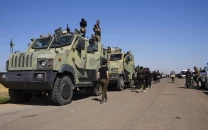How Taliban takeover complicated Iran's refugee crisis
Half a million more Afghans fled to Iran since Taliban’s seizure of Kabul last year

Murtaza Noori, 28, navigated a perilous trek along the 600-mile border with Iran days after the Taliban laid siege to Kabul last August, as tens of thousands of Afghans fled the country, leaving behind their homes, belongings, and dreams.
The largely porous border with neighbouring Iran became a lifeline for many Afghans like Noori, who were not lucky enough to find a space in US military evacuation flights.
Noori, who had printed his wedding cards when the motorcycle-borne, Kalashnikov-yielding Taliban fighters dramatically entered Kabul city on August 15, had to shelve the plan and look for an escape route.
"It was a tough call, but there was no other choice," said the former military apprentice. "It was a choice between life and death as many of us thought the new rulers would go for everyone remotely associated with state-run institutions."
Originally from the southeastern city of Ghazni, and living in Kabul, Noori tried his luck with evacuation flights at the Hamid Karzai International Airport, but failed and then decided to take the road trip to Iran.
Also read: 'Cruel' action on Afghan refugees in Iran sparks outrage
The ordeal wasn't over yet. He found himself crammed in a pickup with many other Afghans, at the mercy of smugglers and border guards. The trek between Nimrooz in southwest Afghanistan and Sistan-Baluchestan in southeast Iran was particularly arduous, he recollected.
After spending days at a government camp in Hirmand county in Sistan, Noori made his way to Tehran with the help of smugglers, who demanded hefty money.
For the next few weeks, he remained locked up on the outskirts of the capital city until one of his Afghan friends in Tehran bailed him out.
"It's a dangerous journey, marked by fear and anxiety every step of the way, and then there is uncertainty over where you are headed, what is in store," Noori told Anadolu Agency.
In the last nine months, the 28-year-old has tried multiple jobs - construction worker, gardener, salesman, night watchman, in many Iranian cities, "just to survive.”
Heavy toll
According to official estimates, more than half a million Afghans have flocked to Iran since August 2021, most of them through smuggling networks and without legal documents.
Norwegian Refugee Council (NRC) in November last year put the number of daily arrivals at 4,000-5,000, compared to 1,400-2,500 before the Taliban’s seizure of Kabul.
Following the new arrivals, an estimated four million Afghans are currently stationed in Iran — 780,000 of them documented with 586,000 holding passports – and around three million of them undocumented.
Mohammad Jawadi, 31, arrived in Iran's northeastern Mashhad city from western Afghanistan's Herat province through the Islam Qala-Dougharoun border crossing in February this year.
Barely two months after his arrival, tensions erupted between the two sides following a fatal stabbing incident, allegedly by an Afghan national, at the revered Imam Reza shrine in Mashhad, in which two clerics were killed.
The incident sent shockwaves across the country and stoked public anger. In the days following, many viral social media videos showed harassment of Afghan migrants in Iran, which saw immediate retaliation in Afghanistan as protesters attacked Iranian diplomatic missions in Kabul and Herat.
Also read: Iran closes Afghan border crossing after skirmishes with Taliban
Jawadi and his friends locked themselves up in their one-room accommodation in Mashhad for weeks, fearing a backlash.
"It was a terrible time for all Afghan refugees in Iran as they feared the backlash of the stabbing incident as well as attacks on Iran's embassy in Tehran and consulate in Herat," he told Anadolu Agency over the phone.
Iran's special envoy for Afghanistan Hassan Kazemi Qommi blamed tensions between the two countries on “enemies” while Afghanistan's caretaker Foreign Minister Amir Khan Muttaqi called for an end to "ill-treatment of Afghan refugees" that he said was "allowing antagonists to conspire."
In the wake of the Mashhad incident, Iran's Foreign Ministry spokesperson Saeed Khatibzadeh said the “waves of displaced Afghans" cannot continue coming to Iran because of the country's "limited capacities.”
The incident coincided with border skirmishes between the two sides due to a disagreement over road construction by the Taliban near the common border, which prevented Jawadi from heading back home.
"The severe economic crisis in Iran, inflation, lack of money is taking a heavy toll on not only Iranians but also migrants like us," he said, revealing plans to head to Türkiye and further to Europe "if luck favours".
Fear, uncertainty
The Iranian government has often complained about the lack of international support for Afghan refugees stationed in Iran for the past 40 years, especially in the face of US sanctions.
While documented Afghans can avail free education as well as some subsidies allocated by the government, around 170,000 of them are also now covered by the UN refugee agency's health insurance scheme.
However, undocumented Afghans like Noori and Jawadi face difficulties even in opening a bank account, renting a home, or getting a SIM card in their name.
"I still do not have a SIM card in my name, and of course no health insurance, either from the Iranian government or the UN refugee agency," said Mohsen Rezaei, 27, who came to Iran with Jawadi.
In January, Ivo Freijsen, the UN refugee agency representative in Iran, urged the international community to increase its support to Iran given the presence of millions of refugees in the country and with more coming since August last year.
Also read: Who destroyed Afghanistan?
He also spoke about plans to resettle Afghan refugees in third countries to lessen the burden on Iran and to identify and register new refugees who lack legal documents.
In an unprecedented move last month, the Iranian government launched a new census of refugees, which was initially supposed to end on June 7 but extended by two weeks, through which undocumented refugees will receive temporary stays of up to six months, which can later be extended.
Meanwhile, there are also concerns about the growing percentage of child laborers in Iran, most of them Afghan migrants, and the phenomenon according to officials has increased 20 times since August 2021.
Also, thousands of Afghans without legal travel documents have been deported since January this year, according to official sources.
Jawadi, now working at a farm in the western Iranian province of Hamadan, has applied for the six-month residency permit, but the clouds of fear and uncertainty loom large.
"Fear and uncertainty are constant now, our lives have been upturned," he said, in an exasperated tone.



















COMMENTS
Comments are moderated and generally will be posted if they are on-topic and not abusive.
For more information, please see our Comments FAQ